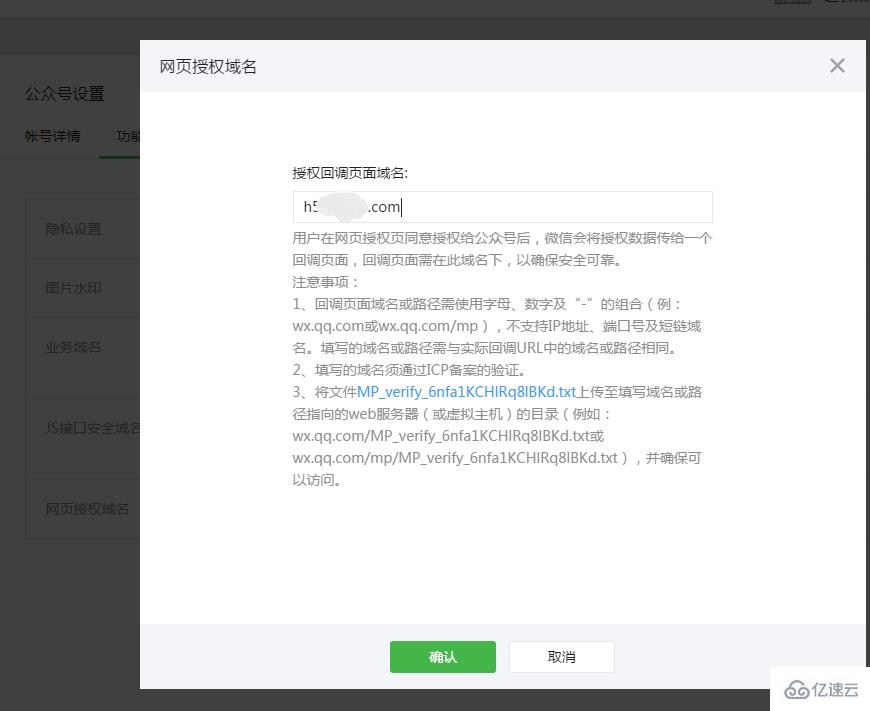您好,登录后才能下订单哦!
这篇文章主要介绍微信开发之Author网页授权的示例分析,文中介绍的非常详细,具有一定的参考价值,感兴趣的小伙伴们一定要看完!
微信开发中,经常有这样的需求:获得用户头像、绑定微信号给用户发信息.. 那么实现这些的前提就是授权!

在微信公众号请求用户网页授权之前,开发者需要先到公众平台官网中的“开发 - 接口权限 - 网页服务 - 网页帐号 - 网页授权获取用户基本信息”的配置选项中,修改授权回调域名,值得注意的是这里就是直接写全域名,如: www.liliangel.cn。然而我们开发h6中一般用的是二级域名,如:h6.liliangel.cn 也同样在安全回调域名中。

微信更新后,授权页也变化了。其实习惯了绿色的那个经典页面..
var center = {
init: function(){
.....
},
enterWxAuthor: function(){
var wxUserInfo = localStorage.getItem("wxUserInfo");
if (!wxUserInfo) {
var code = common.getUrlParameter('code');
if (code) {
common.getWxUserInfo();
center.init();
}else{
//没有微信用户信息,没有授权-->> 需要授权,跳转授权页面
window.location.href = 'https://open.weixin.qq.com/connect/oauth3/authorize?appid='+ WX_APPID +'&redirect_uri='+ window.location.href +'&response_type=code&scope=snsapi_userinfo#wechat_redirect';
}
}else{
center.init();
}
}
}
$(document).ready(function() {
center.enterWxAuthor();
}以scope=snsapi_userinfo为例,页面加载的时候进入授权方法,首先从缓存获取wxUserInfo对象,如果有说明之前已经授权过,直接进入初始化方法。如果没有,判断url是否包含code,有code说明是进入授权页回调后的页面,那么通过code换取用户信息即可。没有code,即用户第一次进入该页面,引导去授权页,redirect_uri为当前页面地址。
/**
* 授权后获取用户的基本信息
*/
getWxUserInfo:function(par){
var code = common.getUrlParameter("code");
if (par) code = par;
$.ajax({
async: false,
data: {code:code},
type : "GET",
url : WX_ROOT + "wechat/authorization",
success : function(json) {
if (json){
try {
//保证写入的wxUserInfo是正确的
var data = JSON.parse(json);
if (data.openid) {
localStorage.setItem('wxUserInfo',json);//写缓存--微信用户信息
}
} catch (e) {
// TODO: handle exception
}
}
}
});
}, /**
* 微信授权
* @param code 使用一次后失效
*
* @return 用户基本信息
* @throws IOException
*/
@RequestMapping(value = "/authorization", method = RequestMethod.GET) public void authorizationWeixin(
@RequestParam String code,
HttpServletRequest request,
HttpServletResponse response) throws IOException{
request.setCharacterEncoding("UTF-8");
response.setCharacterEncoding("UTF-8");
PrintWriter out = response.getWriter();
LOGGER.info("RestFul of authorization parameters code:{}",code);
try {
String rs = wechatService.getOauthAccessToken(code);
out.write(rs);
LOGGER.info("RestFul of authorization is successful.",rs);
} catch (Exception e) {
LOGGER.error("RestFul of authorization is error.",e);
}finally{
out.close();
}
}这里有一个授权access_token,切记:授权access_token非全局access_token ,需要使用缓存,这里我使用的redis,具体配置不多说后面写相关配置博文,当然也可以使用ehcache,关于ehcahe配置在我的第一篇博客中有详细介绍。
/**
* 根据code 获取授权的token 仅限授权时使用,与全局的access_token不同
* @param code
* @return
* @throws IOException
* @throws ClientProtocolException
*/
public String getOauthAccessToken(String code) throws ClientProtocolException, IOException{
String data = redisService.get("WEIXIN_SQ_ACCESS_TOKEN");
String rs_access_token = null;
String rs_openid = null;
String url = WX_OAUTH_ACCESS_TOKEN_URL + "?appid="+WX_APPID+"&secret="+WX_APPSECRET+"&code="+code+"&grant_type=authorization_code"; if (StringUtils.isEmpty(data)) { synchronized (this) { //已过期,需要刷新
String hs = apiService.doGet(url);
JSONObject json = JSONObject.parseObject(hs);
String refresh_token = json.getString("refresh_token");
String refresh_url = "https://api.weixin.qq.com/sns/oauth3/refresh_token?appid="+WX_APPID+"&grant_type=refresh_token&refresh_token="+refresh_token;
String r_hs = apiService.doGet(refresh_url);
JSONObject r_json = JSONObject.parseObject(r_hs);
String r_access_token = r_json.getString("access_token");
String r_expires_in = r_json.getString("expires_in");
rs_openid = r_json.getString("openid");
rs_access_token = r_access_token;
redisService.set("WEIXIN_SQ_ACCESS_TOKEN", r_access_token, Integer.parseInt(r_expires_in) - 3600);
LOGGER.info("Set sq access_token to redis is successful.parameters time:{},realtime",Integer.parseInt(r_expires_in), Integer.parseInt(r_expires_in) - 3600);
}
}else{ //还没有过期
String hs = apiService.doGet(url);
JSONObject json = JSONObject.parseObject(hs);
rs_access_token = json.getString("access_token");
rs_openid = json.getString("openid");
LOGGER.info("Get sq access_token from redis is successful.rs_access_token:{},rs_openid:{}",rs_access_token,rs_openid);
}
return getOauthUserInfo(rs_access_token,rs_openid);
}
/**
* 根据授权token获取用户信息
* @param access_token
* @param openid
* @return
*/
public String getOauthUserInfo(String access_token,String openid){
String url = "https://api.weixin.qq.com/sns/userinfo?access_token="+ access_token +"&openid="+ openid +"&lang=zh_CN";
try {
String hs = apiService.doGet(url);
//保存用户信息
saveWeixinUser(hs);
return hs;
} catch (IOException e) {
LOGGER.error("RestFul of authorization is error.",e);
}
return null;
}当时赶时间,代码命名较乱。可以看到,我用了一个同步的方法,先从缓存中获取key为WEIXIN_SQ_ACCESS_TOKEN,如果取到了说明没有过期,直接通过httpclient调用微信提供的接口,返回用户信息的字符串给前端。如果没有取到,说明没有或者已经过期,则根据refresh_token刷新access_token,再写缓存,由于access_token拥有较短的有效期,为了保险我这里设置了缓存的失效时间微信给的时间再减一个小时。回过头来看代码发现,上面的逻辑有点点小问题,这样写会导致第一次获取或者缓存失效后第一次获取access_token都会去刷新一次,暂时不影响使用,后面做优化修改 TODO。
通常情况下,授权后我们会将用户信息保存数据库表,openid为唯一主键,外键关联起我们自己的用户表,这样一来,无论是后续要开展什么业务,还是做运营数据统计,都有了一个跟微信公众号的关联关系。值得注意的是:我们获取到的headimgurl是微信提供的一个url地址,当用户修改头像后可能导致原来的地址失效,所以最好是通过将图片保存到本地服务器然后保存本地的地址url!
微信返回的值:

以上是“微信开发之Author网页授权的示例分析”这篇文章的所有内容,感谢各位的阅读!希望分享的内容对大家有帮助,更多相关知识,欢迎关注亿速云行业资讯频道!
免责声明:本站发布的内容(图片、视频和文字)以原创、转载和分享为主,文章观点不代表本网站立场,如果涉及侵权请联系站长邮箱:is@yisu.com进行举报,并提供相关证据,一经查实,将立刻删除涉嫌侵权内容。